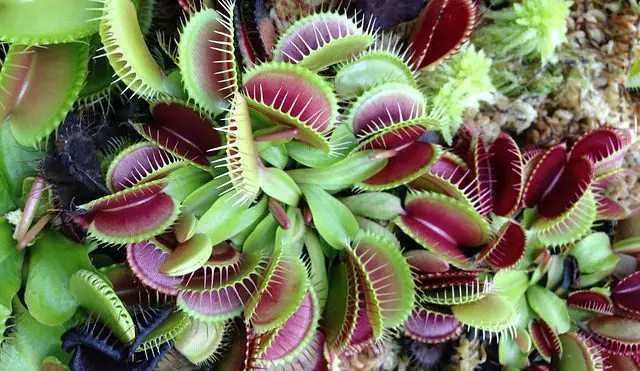The color of Venus flytraps can be associated with the health of the plant. I would like to share what I have learned while growing Venus flytraps on how certain color changes are great signs, and others are a warning.
Healthy Venus flytraps exhibit bright green colors in the leaves and burgundy or reddish colors inside the traps. It is not uncommon to spot black leaves within the plant as they are part of the plant’s life cycle. Also, poor growing conditions can turn leaves yellow or light brown.
However, not all color changes are strict indications of your plant’s health. Keep on reading to determine what do color changes in Venus flytraps mean and how to follow proper care instructions.
| Venus Flytrap Color Change | Effect | Possible Causes |
| Bright red color inside the traps | Positive | The plant is receiving enough lighting. |
| Black or brown leaves | Neutral | Black or brown leaves are just leaves that have dried up and died. They are usually normal in Venus flytraps, especially during dormancy. Check the plant’s growing conditions if you notice an increase in dead leaves. |
| Yellow leaves | Negative | A sign of poor growing conditions due to using the wrong water source, overwatering or employing the incorrect soil. |
| Black spots in the plant’s bulb | Negative | The Venus flytrap is likely suffering from root rot. Act quickly to save your plant. |
| Red spots in the leaf base | Negative | The plant has been exposed to extremely high heat and it has gotten burnt. Temperatures above 95F can dry out and burn Venus flytraps. |
| Purple coloring | Neutral | Some varieties of Venus fly trap characterize with deep Burgundy colors which often look close to purple, like the Akai Ryu variety. Follow the link to learn more about fully red plants. |
| Blue coloring | Negative | Blue Venus fly traps do not exist. They are often advertised by scammers. |
Venus Flytrap Colors
The Venus flytrap characterizes with bright green and bright red colors. However, not all varieties of Venus flytraps exhibit the green and red combination.
Some variations are fully red (all around) and some others are completely green (no sign of red). For example, the Akai Ryu cultivar of Venus flytrap is deep burgundy in color. Sometimes, you can spot some green in the border of the traps, but the majority of the plant is marron.
In this article we will focus on the standard varieties of Venus flytraps. Like this one shown in this image:
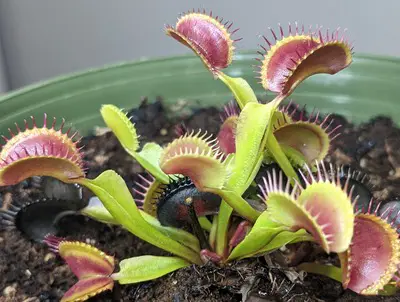
Lack of Red Coloring
Sometimes Venus flytraps lose the red coloration inside the traps, or the color starts fading. The lack of red coloring in the traps is due to light starvation or lack of enough lighting.
The primary food source of Venus flytraps is photosynthesis. When the plant does not receive enough light, then it abandons other efforts, such as catching prey to focus on photosynthesis. As a self-defense mechanism, the plant grows completely green leaves without the red color inside the traps.
When a plant loses the red inside the traps, it is a clear sign that it needs more lighting. The fix is usually very easy. You can place your plant in a better spot with more access to sunlight.
Twelve hours of light is optimal for Venus fly traps.
When you move the plant around and the lighting level changes, try to make a step-by-step transition. Slowly introduce your plant to more and more lighting. Besides sunlight, you can consider employing artificial lighting to supplement your plant’s needs This solution is practical and cheap.
I use this LED plant light for some of the Venus flytraps I own and my plants are thriving. The plant light has the appropriate lumen level (1500 lumens) and color spectrum (6500K cool white). Also, it comes with a built-in timer to turn on/off automatically.
Venus flytraps won’t die immediately if they do not receive proper, but the plant will start to weaken and can eventually die.
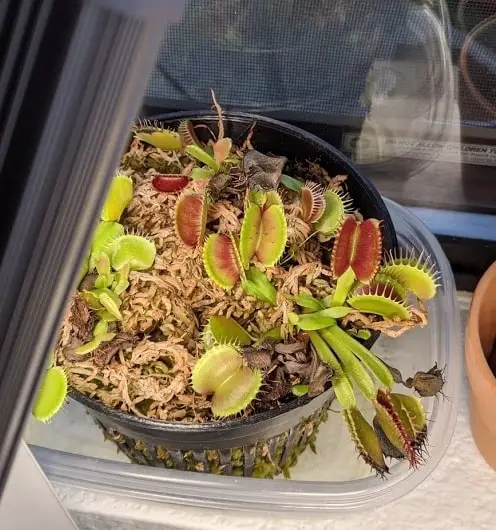
Bright Red Color
A bright red color inside the traps is a sign of good health. It means your plant is receiving all the lighting it needs. The red color inside the traps helps the Venus flytrap capture prey.
The plant attracts prey with sweet nectar and bright colors. The bright red color in the trap mimics a flower. Confused and hungry insects end up inside the traps.
When your plant shows the perfect color combination, then you can focus on feeding it. If you placed your plant outside, it can catch its own bugs. But indoors, Venus flytraps struggle to capture prey. To ensure the plant continues to thrive, I recommend feeding them once every month during the growing season. You can learn how to feed a Venus flytrap with this short guide: Venus Flytrap Feeding Guide.
The plant will conserve the colors as long as the environment does not change and it will have access to more nutrients thanks to the bugs.
For reference, here is an example of a unique variety of Venus fly trap that is almost completely red.
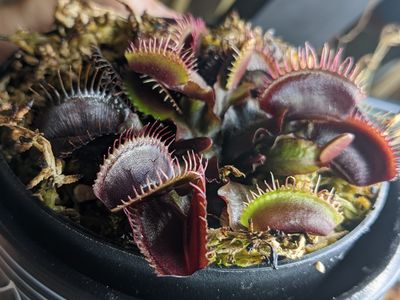
Black Leaves
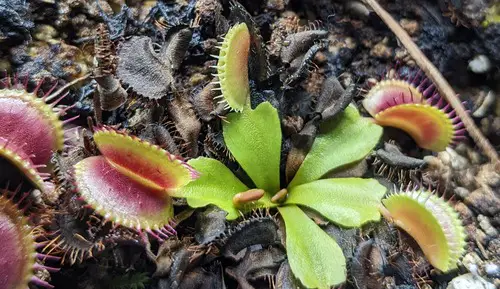
Generally, black or brown leaves within a Venus flytrap are normal. Each leaf only lives over a certain period. For example, once a trap has closed a handful of times, then that leaf that contains the trap will start to wither and darken.
Many other factors can affect the plant and generate black leaves. When you observe an increasing number of black leaves, then it is a warning sign to take action. This article explains in detail the cause of black leaves and offers easy-to-implement solutions => Why Do Venus Flytraps Turn Black?- Reduce Black Leaves Today
These are the main causes of black leaves in Venus flytraps:
Improper Feeding
Improper feeding can cause black leaves. When the plant is fed with bugs that are too large for the trap or with human food, it will have problems. Human food can be meat, candy, or fruit, anything that is not an insect or a spider.
Venus flytrap will have trouble digesting large bugs or human food. First, the trap will start to digest the content inside its trap. But if unsuccessful after a reasonable amount of time, the plant will decide to abandon its efforts and will let the leaf wither.
It is normal to make mistakes when feeding a Venus flytrap for the first time. For example, selecting the wrong food for your plant is a common mistake. I wrote this article on Venus flytrap feed options to prevent common mistakes.. For example, selecting the wrong food for your plant is a common mistake. I wrote this article on Venus flytrap feed options to prevent common mistakes.. You should start by practicing and then perfect your feeding procedure to avoid hurting the Venus flytrap.
Mechanical Stress
Poking or touching the traps excessively can contribute to an increase in black leaves. Each trap can only open and close a certain number of times before it withers. If a human sets the traps just for being curious, then the plant will waist energy. Besides, the leaf will live for a shorten span. Avoid, exposing your plant to mechanical stress. The least contact with curious fingers or pets the better.
Dormancy
During the winter months, Venus flytraps undergo a dormancy process. During such a period, which usually lasts 2 to 3 months, many leaves turn black and die while the plant reduces in size. The presence of black leaves during dormancy is normal.
The Natural Cycle
Remember, black leaves are usually normal. Only take action when you notice a change in the appearance of your plant. Also, you can always trim the dead leaves of your plant. Trimming Venus flytraps help them have more space and make them picture ready!
Venus Flytrap Leaves Yellowing / Browning
Sometimes leaves in Venus flytraps start to yellow or brown before they blacken. Yellow leaves are common sign of poor growing conditions. If you notice one leaf yellowing, it could just be dying due to natural causes. However, if instead several leaves are yellowing and your plant is down. Then, your plant’s health is at risk.
The most common causes of yellow leaves are:
- Improper soil
- Wrong water source
- Overwatering
Now, let’s go over each item in detail:
Improper Soil
You can’t use standard plant soil for Venus flytraps. Venus flytraps need a mineral-free nutrient-free medium to grow. When you plant Venus flytraps in standard soil you poison the pant with minerals which the plant can’t process.
Incorrect potting media can be the cause of yellow and black leaves. Pot in a mixture of moss (sphagnums or peat moss) with a draining agent such as perlite or sand. You can also pot your Venus flytrap in just sphagnum moss or peat moss, but drainage can be a challenge in the future. When you buy the potting media, make sure no nutrients were added to it.
You can buy carnivorous plant soil online, like this one I use. It usually costs less than 10 dollars for a quart. Follow the link to confirm the price in Amazon.com.
Follow this link to get all the information about Venus flytrap soil, including where to get it: The Best Soil Options for Venus Flytrap
Wrong Water Source
Venus flytraps can only be watered with distilled water, reverse osmosis water, or rainwater. Straight tap water or bottled water can kill your plant. Venus flytraps die very quickly when they receive the wrong water source.
Overwatering
Overwatering can also cause yellow leaves. The ground for Venus flytraps should always remain humid, but you should never flood it. When the plant is struggling with the high amounts of water, some leaves turn yellow, and the roots might start rotting.
When you water Venus flytraps, you can test the humidity level by merely pressing the soil with your bare finger. The soil should be humid, but your finger should never get wet by simply pressing the ground. If you believe you have been over-watering your plant space out your watering routine.
To prevent making mistakes when watering a Venus flytrap, read this article where I teach all I know about watering: Venus Flytrap Watering Procedure: Source, Frequency and Tips
Red Coloring in Leaf Base
The Leaves of Venus flytrap should exhibit bright green colors. Any type of red coloring in the leaf base is a warning sign. It is usually caused by high heat exposure.
Red spots in your plant can be sunburn, which might be caused by natural or artificial lighting.
Venus flytraps are resilient plants, they can withstand heat over 95 F or 35 C without a problem, but temperatures exceeding those boundaries can dry out and burn your plant.
When you spot red coloring in the leaf base, you should consider moving your plant away from extreme temperatures.
I live in Arizona, and during summer season it is impossible to place my Venus flytraps outdoors without any type of shade. I have made the mistake before and lost a plant after just one day of heat exposure (it was 115 F / 46 C).
Avoid drying out your plant and burning it by follow these advise:
- I recommend changing the artificial lighting if you are using one to a cool color which does not emanate high temperatures. Recommended: High output fluorescent lights or high power LEDs.
- Avoid extremely sunny windows that intensify the intensity of the sun
- Consider misting your plant to increase humidity
- Use a gardening shade cloth or place your plant in partial shade if the temperatures exceed 90 F
Black Spots in Bulb
Black spots in the root bulb of your Venus flytrap are clear signs of root rot. First, if you can observe the root rot while your plant is potted. That is a problem, the bulb should always be underground.
The rot is usually caused by a combination of excessive moisture and the presence of fungus or bacteria. Besides the color changes on the bulb, you might also notice an unpleasant smell within your plant and a change of texture in the bulb.
How to Fix
Root rot can spread through your plant and kill it quickly. Follow these instructions to save your plant:
- Remove the plant from the pot.
- Rinse the roots and bulb with distilled water.
- Use a sharp knife or scissors to remove the affected area of the root and leaves.
- Rinse the plant again.
- Ensure there is no root rot left in the bulb.
- Empty the soil in the pot and clean it thoroughly. You need to remove any leftover fungus or bacteria.
- Place the new soil in the pot.
- Plant your Venus flytrap in the clean pot with brand new soil.
- Water your plant until the soil is moist all around.
- Monitor your Venus flytrap until it recovers. It will probably appear weak for several weeks. The spur of new leaves is always a good sign.
To prevent harming the bulb of your plant, in the future, avoid overwatering your plant. Many new owners believe Venus flytraps grow in swamps, and they tend to water too much. Venus flytraps do need a continuously moist environment, but the soil should never be damped.
Read the complete guide to prevent and eliminate Venus flytrap root rot.
Venus Fly Trap Care
Here is a quick overview on overall care that summarizes what was covered in the article and a lot more!
Light: Optimally they should receive 12 hours of sunlight, and the minimum is 6 hours of light. The light source might be natural light or artificial lighting (plant lights)
Water: Venus flytraps must be watered with pure water only, such as rainwater, distilled water, and reverse osmosis water. Tap water and bottled water kill carnivorous plants.
The soil of the plant must always remain moist. Always keep the ground humid, but do not flood. Venus flytraps do not grow in swamps.
Soil: Employ nutrient-free soil for carnivorous plants. Never employ enriched soil, full of fertilizers. This article covers many soil options for Venus flytraps.
Feeding: Venus flytraps do not need to capture insects to survive, but they benefit from them greatly. Place Venus flytraps outdoors, and they will have plenty of access to food. Also, consider feeding your plant to provide extra nutrients.
Fertilizers: Do not fertilize Venus flytraps. The chemicals in the fertilizers can hurt the plant
Flowers: After reaching maturity, Venus flytraps start producing flowers every spring. Skipping it allows for further growth and development.
Dormancy: Venus flytraps must undergo a dormancy period for 2-3 months during the winter. Ensure your plant will experience this resting period by placing them in a cold location. For example, outdoors, in a cold garage, or porch.


